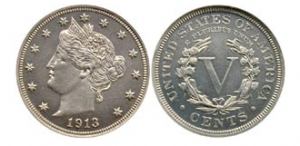The Rogue Charm of the 1913 Liberty Head Nickel
Posted on1913 Liberty Head Nickels are so rare that even the US mint doesn’t know where it came from. They never authorized the piece. Despite this fact, a few of these coveted coins exist. In 2010 one sold for $3.7 million. The question remains, where did this mysterious coin come from?

Between 1883 and 1912 the US Mint issued the Liberty Head Nickel. Eventually, the mint decided on a new design, the Indian Head Nickel. They were to be the first official nickels of 1913. As a result, the official records of the US mint show no indication of any 1913 Liberty Head Nickels.
Then came Samuel Brown.
He had five 1913 Liberty Head Nickels in his possession. No one knew how he found them. Then, some started looking into his past.
They learned that in 1913 Brown was an employee of the US Mint. His position gave him access to the minting process. Many concluded he struck these unauthorized pieces. He may have worked with others at the mint to accomplish this, however, details are unclear.
Historians note that rogue minting has happened before. There are 15 known 1804 silver dollars all of which were struck in the 1830s or after.
In 1924 Brown sold all five nickels, the finest of which is known as the Eliasberg specimen. As a result, this particular piece has been an object of desire for wealthy collectors. The Eliasberg specimen has passed from one person to the next fetching more money with every sale. The most recent sale, occurring in 2007, commanded $5 million for the single coin.
Despite this enormous sum, the Olsen specimen is the most famous of the five. King Farouk of Egypt once owned this piece. As with the Eliasberg specimen, the price has soared with each transaction. In 2004 it sold for $3 million.
Another piece, the Walton specimen sat for 40 years in a closet. The coin was returned to the collector’s family after the owner died in a car crash. He was on route to a coin show and was prepared to exhibit the rare piece. After officials sorted through the wreckage, which consisted of more than $250,000 in rare coins, they incorrectly determined that the 1913 Liberty Head Nickel was not genuine. For this reason, the family put it in a box in a closet and forgot about it. Later, the family learned of a coin show exhibiting the other four pieces. They also learned of a well-publicized effort to find the long lost fifth piece.
They dug through the closet and brought the coin to the show. Experts examined the piece and determined that it was real. They appraised the coin at $2.5 million, but it sold at auction for more than $3 million.
The remaining two coins, the Norweb and the McDermott specimens, have less storied histories because both have long been in the possession of museums.
Today, the coins are a reminder of how much we’ve come to value the charm of a rogue US mint worker with a bit of extra time on his hands.







